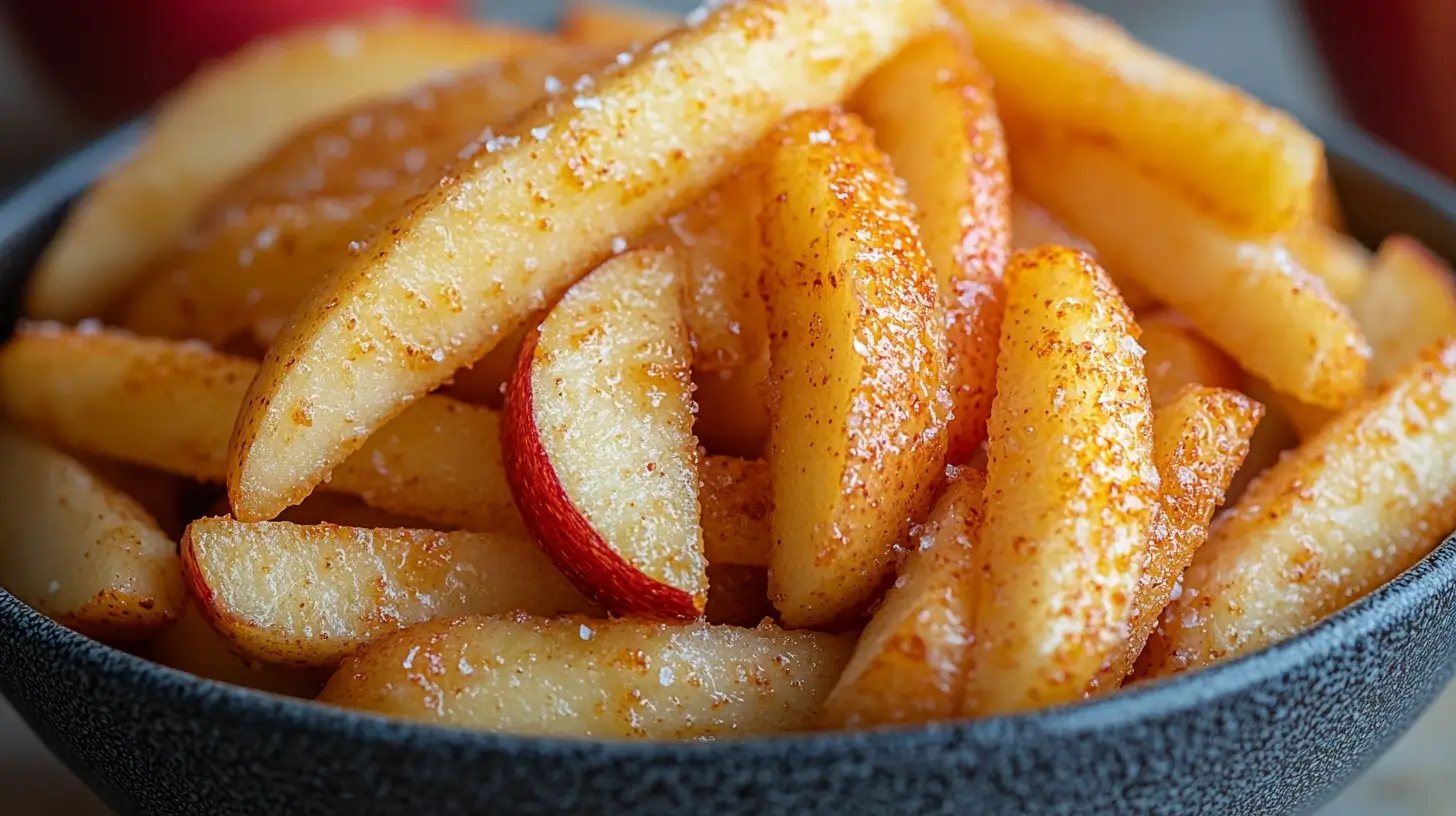There’s something undeniably comforting about the aroma of fried apples sizzling in a skillet. This humble dish, often associated with cozy kitchens and cherished family gatherings, brings a delightful mix of sweetness, warmth, and nostalgia. Whether served as a side dish, a dessert, or a breakfast topping, fried apples have a way of turning an ordinary meal into something special. In this article, we’ll explore the magic behind this timeless treat—starting with its rich history, then diving into the best techniques, flavor combinations, and serving suggestions to help you make the perfect fried apples every time.
A Dish Rooted in Tradition
Fried apples have a long-standing place in culinary history, particularly in Southern kitchens across the United States. Early American settlers quickly discovered that frying apples with a touch of butter, sugar, and cinnamon created a dish that was not only simple but also incredibly satisfying. The recipe required minimal ingredients—perfect for households that needed to make the most of their pantry staples.
Over time, the dish became more than just a practical solution for using up an abundance of apples; it evolved into a cherished tradition. Grandmothers passed down their secret techniques for achieving that perfect balance of tender fruit and rich, caramelized sweetness, ensuring that each generation could recreate the comforting taste of fried apples.
Cultural Significance Across Generations
From Sunday brunch tables to holiday feasts, fried apples have remained a constant presence. In Southern cuisine, they’re often served alongside biscuits, pork chops, or pancakes—adding a touch of sweetness to savory dishes. But the appeal of fried apples extends far beyond regional traditions. Across the globe, variations of fried apples can be found in German Apfelpfannkuchen, French tarte Tatin, and Eastern European apple pancakes, proving that the allure of caramelized apples transcends cultural boundaries.
The Science Behind the Sweetness
Ever wondered why fried apples taste so irresistible? It’s all about the caramelization process. When apples are cooked in butter and sugar, their natural sugars undergo the Maillard reaction, which enhances the fruit’s flavor and aroma. The heat breaks down the apple’s pectin, resulting in that soft-yet-firm texture we all love. And when you add a sprinkle of cinnamon or nutmeg? Pure magic.
Essential Ingredients and Tools for Perfect Fried Apples
Choosing the Right Apples
Not all apples are created equal when it comes to making fried apples. The best varieties strike a balance between sweetness and tartness, while holding their shape during cooking. Granny Smith apples, with their crisp texture and tart flavor, are a classic choice. If you prefer a sweeter dish, Honeycrisp or Fuji apples work wonderfully.
Key Ingredients for Maximum Flavor
While fried apples only require a handful of ingredients, each one plays a crucial role:
- Fresh apples: The star of the show—choose firm, fresh apples for the best results.
- Butter: For rich, buttery goodness.
- Sugar: Brown sugar adds a warm, molasses-like sweetness, while granulated sugar keeps it light and crisp.
- Spices: Cinnamon is a must, but nutmeg or allspice can add a unique twist.
- Lemon juice: A splash prevents the apples from browning and balances the sweetness with a slight tang.
Essential Tools for Frying Success
- Cast-iron skillet: Distributes heat evenly for that perfect caramelization.
- Wooden spoon: Helps stir the apples without damaging the skillet.
- Measuring spoons: Precision matters when balancing flavors.

Mastering the Art of Cooking Fried Apples
Step-by-Step Cooking Guide
- Prep the Apples: Peel, core, and slice the apples evenly—thick enough to stay firm but thin enough to cook through.
- Melt the Butter: Heat butter in a skillet over medium heat until melted and bubbling.
- Add Apples and Sugar: Stir in the apples, sugar, and spices, ensuring each slice is coated.
- Simmer and Stir: Cook until the apples are tender and the syrup thickens.
- Finish with Lemon Juice: Stir in lemon juice for a bright, fresh finish.
Tips for Perfect Fried Apples Every Time
- Don’t overcrowd the skillet: Too many apples can steam instead of fry.
- Keep the heat moderate: High heat causes the sugar to burn before the apples soften.
- Taste as you go: Adjust sugar and spices to suit your preference.

Creative Serving Ideas for Fried Apples
Sweet and Savory Pairings
One of the best things about fried apples is their versatility. They can be enjoyed in both sweet and savory dishes, making them a perfect addition to various meals. Here are some creative serving ideas:
- Breakfast Bliss: Spoon warm fried apples over pancakes, waffles, or French toast. The caramelized syrup seeps into the layers, creating a mouthwatering breakfast treat.
- Savory Delight: Serve alongside pork chops or roasted chicken for a delicious contrast of sweet and savory flavors. The natural sugars in the apples enhance the richness of the meat.
- Dessert Magic: Top vanilla ice cream or creamy rice pudding with a generous scoop of fried apples. The warm apples paired with the cold ice cream create a delightful temperature contrast.
For more sweet ideas, check out this creamy banana pudding trifle recipe: Creamy Banana Pudding Trifle. It’s a perfect dessert option when you’re craving something fruity.
Unique Twists to Try
- Apple Pie Filling: Use your homemade fried apples as a shortcut for apple pie or apple turnovers.
- Parfait Layers: Alternate layers of fried apples, yogurt, and granola for a quick, delicious parfait.
- Cheese Platter Companion: Add a bowl of fried apples to a charcuterie board—they pair surprisingly well with sharp cheddar or brie.
Fried apples don’t just belong on the side of your plate—they can elevate your entire meal with their simple, rustic charm.
Tips for Storing and Reheating Fried Apples
Storing for Maximum Freshness
Got leftovers? Fried apples store beautifully if you follow a few simple steps:
- Refrigerator: Place cooled apples in an airtight container and refrigerate for up to 5 days.
- Freezer: Freeze in a sealed, freezer-safe container for up to 3 months. Thaw overnight in the refrigerator before reheating.
Reheating for the Best Taste
When reheating fried apples, you want to preserve their texture and flavor:
- Stovetop: Heat gently over medium-low heat until warmed through, stirring occasionally.
- Microwave: Heat in short intervals, stirring between each one to avoid uneven heating.
- Oven: Bake covered at 350°F for 10–15 minutes if reheating a large batch.
Health Benefits of Fried Apples
Packed with Nutrients
Believe it or not, fried apples can be both tasty and nutritious—especially when made with minimal sugar and healthy fats. Apples are naturally rich in essential nutrients, making them a smart addition to your diet.
- Rich in Fiber: Apples are packed with dietary fiber, which supports digestion and keeps you feeling full longer. A fiber-rich diet also helps maintain stable blood sugar levels.
- Loaded with Vitamins: Apples are a great source of vitamin C, which boosts immunity and promotes healthy skin. Plus, they offer vitamin K, which supports bone strength.
- High in Antioxidants: Apples are full of polyphenols—powerful antioxidants that protect the body from oxidative stress and inflammation.
When you prepare fried apples with heart-friendly ingredients—such as a dash of cinnamon and a touch of natural sweetener—you can enjoy their comforting flavor without guilt.
A Healthier Dessert Option
Compared to sugary pies or heavy pastries, fried apples are a lighter, more natural dessert option. Their natural sweetness means you can skip excessive sugar. For a healthy twist, try cooking them in coconut oil and sweetening with a drizzle of honey or maple syrup.
Boosting Heart Health
Thanks to their fiber and antioxidant content, apples can support heart health. The polyphenols in apples, especially in the skin, help reduce blood pressure and cholesterol levels. So, making fried apples with the skin on can increase their nutritional value.
FAQs About Fried Apples
What apples are best for frying?
The best apples for frying are firm varieties that hold their shape during cooking. Popular choices include:
- Granny Smith: Crisp and tart, perfect for balancing sweetness.
- Honeycrisp: Juicy and sweet, with a delightful crunch.
- Fuji: Firm, sweet, and slightly floral, ideal for caramelization.
- Braeburn: Sweet with a hint of spice, great for warm, cozy flavors.
Avoid softer varieties like Red Delicious or McIntosh, as they become mushy when fried.
What are the benefits of fried apples?
Fried apples are more than just a tasty treat—they also offer several health benefits:
- Rich in Fiber: Apples support healthy digestion and help regulate blood sugar levels.
- Full of Vitamins: Apples provide vitamin C for immunity and vitamin K for bone health.
- Antioxidant Boost: Apples are packed with polyphenols that fight inflammation.
- Natural Sweetener: Fried apples can curb sugar cravings with their natural sweetness, especially when made with minimal added sugar.
What do the French call fried apples?
In French cuisine, fried apples are known as Pommes Sautées or Pommes Caramélisées, depending on the preparation:
- Pommes Sautées: Refers to apples sautéed in butter until golden.
- Pommes Caramélisées: Apples cooked in butter and sugar until they form a caramelized glaze.
The famous French dessert Tarte Tatin is a popular baked dish made with caramelized apples, showcasing a classic French approach to cooking apples.
Why are my fried apples mushy?
Mushy fried apples are often caused by a few common mistakes:
- Wrong Apple Variety: Soft apples like McIntosh break down too quickly—use firm types like Granny Smith or Honeycrisp.
- Overcrowding the Pan: Too many apples at once cause steaming instead of frying. Cook in batches for better caramelization.
- High Heat: Cooking on high heat burns the sugar before the apples cook through—use medium heat and cook slowly.
- Overcooking: Fry the apples until just tender—don’t let them simmer too long.
Final Thoughts on Fried Apples
Fried apples are more than just a simple dish—they’re a comforting classic that blends sweet flavors with warm memories. Whether you enjoy them for breakfast, alongside savory meals, or as a cozy dessert, their versatility knows no bounds. From Southern-style traditions to global variations like French Pommes Caramélisées, fried apples bring joy to every table.
By choosing the right apples, mastering simple techniques, and avoiding common mistakes, you can create a dish that’s both delicious and nutritious. Plus, with their rich history and health benefits, fried apples are a timeless treat worth savoring year-round.

